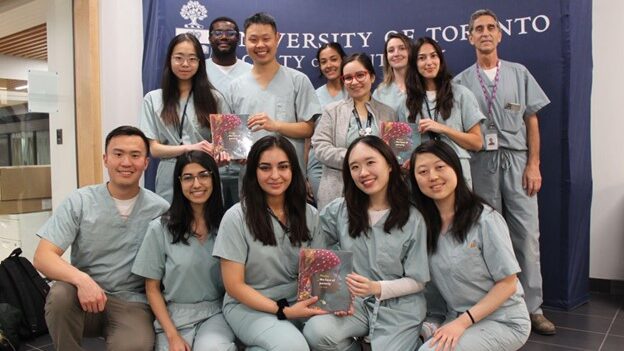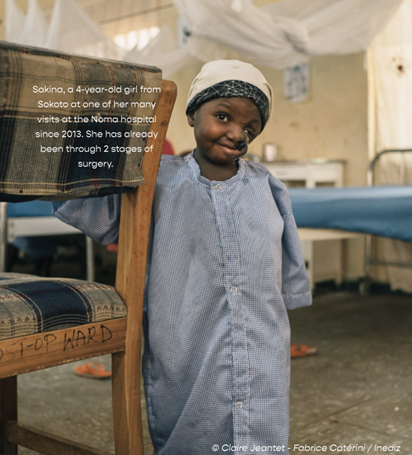
Noma is a rapidly progressing, severe gangrenous condition that targets oral and facial tissues. Originating as a gingival lesion, it can quickly evolve into an ulcerative, necrotizing gingivitis, causing extensive destruction of both soft and hard tissues in the oral-maxillofacial region. Most commonly affecting children aged 2-6 who experience malnutrition, immunocompromise, and poverty, noma is primarily found in sub-Saharan Africa, though cases have also been identified in South America and Asia.1-4 Without intervention, noma leads to fatality in as many as 90% of cases.4 Survivors are often burdened with profound facial deformities that require complex rehabilitation, contributing to difficulty eating and speaking, social isolation and stigmatization. When diagnosed early, its progression can be stopped through basic hygiene, antibiotics, and improved nutrition.1-4
Since its inception in 2020, Noma Action Group (NAG) at the University of Toronto’s Faculty of Dentistry has helped advocate for the inclusion of noma as a neglected tropical disease (NTD) by the World Health Organization (WHO). NAG’s mission is to advocate for noma, raise public awareness of noma, and educate healthcare professionals about the disease. Although my involvement with NAG began in my second year of dental school, I was initially exposed to noma in my first year through a lecture by Dr. Joel Rosenbloom, the co-founder of NAG. The lecture left me inspired and frustrated; noma had claimed the lives of many and had been ignored for far too long. While I am passionate about treating caries and periodontal disease in patients here in Canada, we often overlook high-morbidity oral diseases on a global scale, which sparked my interest in joining NAG. I wanted to become a global citizen and not only help patients in my local community, but also advocate for patients worldwide. I believe that together, with other talented members of NAG, we can make a difference fighting against noma and raise awareness on a global scale.

As part of NAG, Dr. Joel Rosenbloom and Dr. Daniel Haas, former dean of dentistry, urged the Canadian Minister of Health to compose a letter endorsing the Nigerian Dossier for the inclusion of noma as an NTD. This correspondence played a pivotal role in inspiring ministers from various countries to follow suit. Consequently, there are currently 32 letters of support from around the world.5 In December 2023, the WHO officially announced the inclusion of noma as an NTD; this significantly impacts how the disease is viewed on a global scale. Specifically, there will be heightened efforts to promptly identify and manage cases of noma, improve preventative action, and increase mental health counselling to assist with de-stigmatizing noma survivors and integrating them into society. The addition of noma as an NTD further prompts for the accurate epidemiologic monitoring of the disease and fosters international research for treatment interventions.4 The WHO decision holds significant importance for me, as it validates the years of ongoing advocacy that had been put forth by leaders in the field. This decision symbolizes a light at the end of the tunnel; not only is the severity of the disease now officially recognized, but also the commitment of the WHO to take action against this long-neglected condition. The increased research, funding, and attention towards fighting against noma instils hope in me and fellow NAG members.

Although this is a big step forward for noma, more work still needs to be done. Namely, an international campaign is imperative to raise awareness of the condition and increased education is necessary for healthcare professionals to accurately diagnose noma in its early stages. Furthermore, noma’s etiology remains poorly understood, which warrants further research.4 At NAG, we remain committed to becoming global ambassadors for advocacy and continually raising awareness for noma. Aside from the University of Toronto and the University of Western Ontario, new chapters of NAG are being created at various dental schools within Canada, including Dalhousie University and the University of British Columbia, among others. NAG also has the only noma-dedicated website in the Americas, which details what our group has achieved to help advocate for noma as an NTD. While I am only in my third year of dental studies, this decision reminds me that collective efforts locally here at the University of Toronto can lead to a positive change on a global scale; it motivates me to continue advocating for noma even after graduation.
About the Author:
Ken He is a 3rd year dental student at the University of Toronto and a member of NAG. He previously completed an Honours Bachelor of Science at Queen’s University, where he studied life sciences. Ken is interested in oral healthcare disparities and hopes to provide dental care to rural communities in the future. He can be contacted at: ken.he@mail.utoronto.ca

